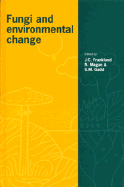Book contents
- Frontmatter
- Contents
- List of contributors
- Preface
- 1 Effects of climate change on fungal diseases of trees
- 2 Effects of climate change on Fusarium foot rot of winter wheat in the United Kingdom
- 3 Effects of UV-B radiation (280–320 nm) on foliar saprotrophs and pathogens
- 4 Implications of global warming and rising sea-levels for macrofungi in UK dune systems
- 5 Red Data Lists and decline in fruiting of macromycetes in relation to pollution and loss of habitat
- 6 Effects of dry-deposited SO2 and sulphite on saprotrophic fungi and decomposition of tree leaf litter
- 7 Effects of atmospheric pollutants on phyllosphere and endophytic fungi
- 8 Influences of acid mist and ozone on the fluorescein diacetate activity of leaf litter
- 9 Mycorrhizas and environmental stress
- 10 Myccorhizas, succession, and the rehabilitation of deforested lands in the humid tropics
- 11 Potential effects on the soil mycoflora of changes in the UK agricultural policy for upland grasslands
- 12 Uptake and immobilization of caesium in UK grassland and forest soils by fungi, following the Chernobyl accident
- 13 Effects of pollutants on aquatic hyphomycetes colonizing leaf material in freshwaters
- 14 Fungi and salt stress
- 15 Fungal sequestration, mobilization and transformation of metals and metalloids
- 16 Urban, industrial and agricultural effects on lichens
- 17 Fungal interactions with metals and radionuclides for environmental bioremediation
- 18 Impact of genetically-modified microorganisms on the terrestrial microbiota including fungi
- 19 Has chaos theory a place in environmental mycology?
- Index of generic and specific names
- Subject index
9 - Mycorrhizas and environmental stress
Published online by Cambridge University Press: 05 November 2011
- Frontmatter
- Contents
- List of contributors
- Preface
- 1 Effects of climate change on fungal diseases of trees
- 2 Effects of climate change on Fusarium foot rot of winter wheat in the United Kingdom
- 3 Effects of UV-B radiation (280–320 nm) on foliar saprotrophs and pathogens
- 4 Implications of global warming and rising sea-levels for macrofungi in UK dune systems
- 5 Red Data Lists and decline in fruiting of macromycetes in relation to pollution and loss of habitat
- 6 Effects of dry-deposited SO2 and sulphite on saprotrophic fungi and decomposition of tree leaf litter
- 7 Effects of atmospheric pollutants on phyllosphere and endophytic fungi
- 8 Influences of acid mist and ozone on the fluorescein diacetate activity of leaf litter
- 9 Mycorrhizas and environmental stress
- 10 Myccorhizas, succession, and the rehabilitation of deforested lands in the humid tropics
- 11 Potential effects on the soil mycoflora of changes in the UK agricultural policy for upland grasslands
- 12 Uptake and immobilization of caesium in UK grassland and forest soils by fungi, following the Chernobyl accident
- 13 Effects of pollutants on aquatic hyphomycetes colonizing leaf material in freshwaters
- 14 Fungi and salt stress
- 15 Fungal sequestration, mobilization and transformation of metals and metalloids
- 16 Urban, industrial and agricultural effects on lichens
- 17 Fungal interactions with metals and radionuclides for environmental bioremediation
- 18 Impact of genetically-modified microorganisms on the terrestrial microbiota including fungi
- 19 Has chaos theory a place in environmental mycology?
- Index of generic and specific names
- Subject index
Summary
The mycorrhizal symbiosis
The rhizosphere and the surface of plant roots are inhabited by populations of several microorganisms. Among these populations, a group of filamentous fungi can be present quite consistently on the root surfaces or in the tissues or cells of the roots, so that dual organs of consistent morphological and histological patterns are formed (Harley, 1989). In these ‘mycorrhizas’ the fungus and the host co-exist actively for long periods in a state called a mutualistic symbiosis. Most plant species in the greater part of the world's ecosystems are infected with these mycorrhizal fungi (Harley & Smith, 1983; Harley & Harley, 1987, Janos, Chapter 10).
Under natural conditions the vast majority of the fungi involved in this association appear to be obligate symbionts, with little or no ability for independent growth. This seems to be less true for the autobionts. Their degree of mycorrhizal dependency is somewhat more variable. Some plant species are infected occasionally while most others (70% of the angiosperms according to Trappe, 1987) cannot complete their life cycles without mycorrhizas, at least in their natural environment. However, environmental factors as well as the presence of companion plants can determine whether a plant is mycotrophic or not in some settings (Miller, 1979; Molina, Massicotte & Trappe, 1992).
- Type
- Chapter
- Information
- Fungi and Environmental Change , pp. 109 - 128Publisher: Cambridge University PressPrint publication year: 1996
- 8
- Cited by

